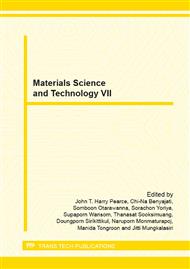p.63
p.69
p.77
p.82
p.89
p.95
p.101
p.109
p.115
The Effects of Ethanol-Diesel-Biodiesel Blends on Fuel Properties
Abstract:
Ethanol, a renewable bio-based resource, is the oxygenation in ethanol-diesel blends, thereby providing the potential to reduce exhaust emissions in compression-ignition engines. However, a major drawback of ethanol-diesel blends is the limited solubility and much difference of viscosity between ethanol and diesel fuel. These limitations result in phase separation, lubricity and properties of blended fuel. Biodiesel, an amphiphile or a surface-active agent, is known as an additive to improve the lubricity of diesel fuel. Therefore, this research is focused on the use of biodiesel as an additive for stabilizing the solubility of ethanol-diesel blends. A comparative study of phase stability of diesel-biodiesel-ethanol blends and an evaluation of some properties such as density, viscosity, pour point and heating value of different concentrations of the blends was carried out. The lubricity of the blended fuels was also investigated by the High Frequency Reciprocating Rig (HFRR). The result showed that the presence of biodiesel can improve fuel instability of the blends at room temperature for three months. Biodiesel, added in the ethanol-diesel blended fuels can improved the lubricity of blends as compared to diesel fuel. An increased amount of ethanol in blends can reduce the wear scar values of a test specimen. In contrast to heating value, density and viscosity at 40 oC of blends increase with increasing the amount of biodiesel.
Info:
Periodical:
Pages:
89-94
Citation:
Online since:
March 2013
Price:
Сopyright:
© 2013 Trans Tech Publications Ltd. All Rights Reserved
Share:
Citation:


